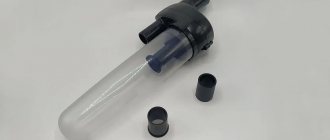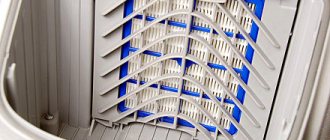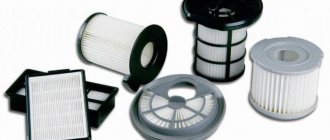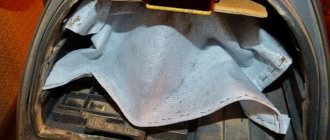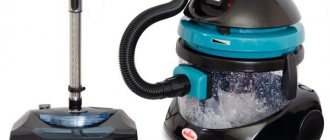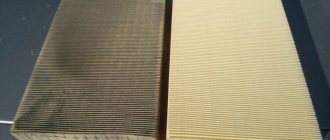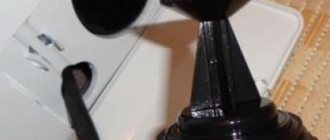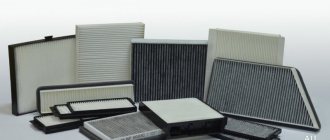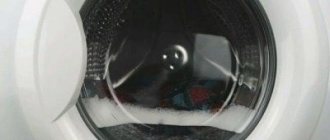The words HEPA filter and air purification are often found nearby, since such filters are mainly used for climate control equipment. A HEPA filter is made from a special material whose fibers are woven in a special pattern to capture pollutant particles from the air. The properties of the material, its thickness and pore size determine the cleaning class and filter efficiency.
When we think of filtration, we usually think of a fine mesh or sieve that allows particles of the same size to pass through while keeping larger contaminants out. The HEPA filter is designed differently and cleans the air from particles smaller than the distance between the filter fibers. The filter material itself is folded like an accordion; its fibers are arranged nonlinearly, so that the air flow passes through the filter fibers many times. The efficiency of the filter is also influenced by the fibers themselves: material, diameter and density of their packing.
How does a HEPA filter work?
First of all, there is still a sieve effect; thanks to it, large particles with a diameter of more than 5 microns are retained, that is, these particles can only be called large relative to even smaller ones, which are also captured by the HEPA filter. In general, purification systems with such filtration are used to retain particles 10 microns in size and smaller. Of course, the HEPA filter is capable of capturing really large particles of dust, fluff and other large pollutants. However, using a HEPA filter in this manner would be wasteful, as large contaminants will quickly clog the filter fibers and reduce its effectiveness. Therefore, it is most optimal to supplement the HEPA filter with a prefilter or a coarse cleaning system; it traps large pollutants, extending the service life of the main filter.
The cleaning mechanisms in such filters are based on three physical processes:
Diffusion. The smallest particles with a diameter of less than 0.1 microns, that is, their size is less than the distance between the filter fibers, are constantly in chaotic movement. Roughly speaking, their mass is so small that, in addition to the general direction of air flow, their trajectory is constantly changing. As a result, when the general air flow bends around the filter fibers, the smallest particles are knocked out due to their chaotic movement and settle on the filter fibers.
Inertia. Heavier particles with a diameter of more than 0.3 microns enter the filter fibers by inertia. The general air flow bends around the obstacles created by the filter material, and “large” particles cannot quickly change the direction of movement, as a result of which they remain in the filter.
Engagement. Particles too large to diffuse and too small to inert do not cut into the filter material as they pass through it. But thanks to the structure of microfibers, particles do not have to get into them - just touch them. A particle clings to the fiber, the next one clings to it, and thus the cleaning of medium-sized particles occurs.
In practice, all three processes occur simultaneously and affect all particles, regardless of their size. The separation is carried out theoretically, since the effectiveness of each process on each type of particle depends on its size.
What else you need to know about the operation of a HEPA filter is a combination of the scary words adhesion and autohesion. The first indicates the interaction of dust particles with the fibers of the filter itself, due to which the particle is deposited on the surface and does not leave it. Autohesion causes the interaction of particles with each other, so that a new layer of pollutants is superimposed on the one already present on the filter fibers. Thus, the filter does not lose its effectiveness for a long time; moreover, with time and an increase in the amount of contaminants in the filter, the efficiency of the filter also increases, since accumulations of already retained particles form “traps” for further contaminants. Also, depending on the properties of the filter material, the fibers can accumulate an electrostatic charge, which firmly holds all “trapped” particles, which increases cleaning efficiency. However, with prolonged use - more than the period recommended by the manufacturer - the filter becomes clogged, it becomes so filled with particles that it loses the ability to pass air flow through it, so it is necessary to replace the filters.
Cleaning the robot vacuum cleaner
To rinse the robot vacuum cleaner from dust and dirt, you need to press the lock button, then take out the container and clean it.
When the device is equipped with a reusable filter, it is washed in running warm water. If the vacuum cleaner is used every day, then the procedure should be performed once every two months.
Be sure to remove dirt and accumulated debris from the brushes. The side brushes and the rotating wheels need to be cleaned.
Regular cleaning of the vacuum cleaner and all parts from dust inside will help prevent the spread of unpleasant odors, as well as bacteria that negatively affect people's health.
How long does a HEPA filter last?
Exactly how long the filter will last and how well it will work depends on the specific model, so you should follow the recommendations for replacement and buy a replacement HEPA filter as soon as the declared resource comes to an end. In addition, if particularly polluted air is subjected to purification, then the filters need to be changed more often, so most manufacturers indicate the service life in the format “up to a year/month”. You can recognize that the filter has outlived its usefulness by the smell of dust emanating from the device, or by a decrease in the power of air flow from the filtration system. People often ask whether the HEPA filter can be washed. For most models, washing will be the last event in life - water causes the filters to become deformed and lose their properties. Washable HEPA filters exist and are marked with a W in their name. Such filters can be cleaned with strong pressure of cold water without brushes or detergents, and then dried at room temperature. However, even washable filters should not be used for more than two years, since they cannot be completely cleaned.
Life time
It is extremely difficult to know in advance how long the filter will last; if the product is used frequently, the filter may become unusable faster than stated by the manufacturer, and, conversely, if used rarely, the filter may last much longer. However, it is worth focusing on the approximate period and taking care of selecting a replacement filter. In some cases, when purchasing equipment with a non-standard and rare filter shape, it is better to immediately buy replacement products; also, the necessary model can most often be found in a specialized store or on the Internet.
It is very easy to recognize the moment when it is time to replace the filter; at this stage, an unpleasant smell of dust appears when the equipment is operating, the power can also be significantly reduced and an extraneous sound may appear.
What types of HEPA filters are there?
The filtration class of all such filters is indicated by numbers and is enshrined in regulatory documents. In Russia, types of HEPA filters are regulated by GOST R EN 1822-1-2010. And according to this document, standards are prescribed for EPA, HEPA and ULPA filters.
Filters are divided into classes according to the principle of integral and local efficiency - the number of passed particles in general, and in a separate area. To determine the cleaning class, filters are tested with fine aerosols, and the air flow coming out of them is examined for the number of particles with the most penetrating size from 0.1 to 0.3 microns. The resulting minimum particle size depends on the filter.
Of course, it is most correct to separate EPA, HEPA and ULPA filters, however, cleaning systems with such filters appeared before the names were finally separated, and users got used to calling filters HEPA. Therefore, manufacturers, including us, prefer to retain the name “HEPA”, which is familiar to customers.
Causes of clogged vacuum cleaners
If the permissible load is exceeded, the vacuum cleaner fails
Equipment intended for cleaning an apartment cannot be used for other purposes. If someone decides to carry out general cleaning after a major renovation using a conventional vacuum cleaner, he will encounter a problem when the unit simply breaks down completely and stops working. The main reason is exceeding the permissible loads. A large amount of debris must have accumulated on the surfaces, and the device quickly clogged. To restore functionality, you must at least empty the bag of dust or wash the cylindrical container.
Another common cause of clogging is the ingress of paper clips, buttons, pins, and other similar small metal or plastic products. They must be removed before starting the device, so it is useful to inspect the floor covering and remove large debris first.
Cheap bags and disposable dust containers become clogged even during simple cleaning. From them, debris and dust get into the motor, it quickly fails. The cheapest models suffer from such problems, so when buying a vacuum cleaner, you should not save. The quality of cleaning directly depends on the installed filters and the volume of containers in which dust and debris are collected.
Sometimes the cause of clogging of the unit is simple human forgetfulness. Many people forget to install the bag inside the device. Before turning on the device, you should check every time that everything is in order with the package.
It is important to check before plugging in whether the hose is tightly attached to the place where the dust collector is installed.
This is interesting: Refrigerator decoupage: how to do it yourself
Where are HEPA filters used?
For the most part, such filtration systems are used in three types of household devices: vacuum cleaners, air purifiers and ventilation units.
Vacuum cleaners usually have simple filters installed to clean the exhaust air from dust inside the device. The most commonly washable HEPA filters are found in vacuum cleaners. The most expensive models are equipped with HEPA filters E10, E11, E12, H13, H14, U15. However, the HEPA E10 filter is most often found in such devices. Moreover, such filters are usually small in size and designed for large air flows at high speeds.
Air purifiers also use HEPA filters. Depending on the level of purifier, the size and quality of the filter changes. Please note that high-class filters are usually protected from deformation by a durable plastic frame - the higher the efficiency of the filter, the more “armor” it needs. High-quality air purifiers most often have a HEPA E11 filter installed. This system is sufficient to effectively clean the circulating air, but when choosing a device, make sure that the filter is not deformed and fits tightly to the body.
Ventilation systems. Supply ventilation often includes filtration systems, but in most cases everything is limited to a prefilter or fine HEPA. The breather is equipped with an E11 HEPA filter, which traps the smallest particles of pollutants from the air, including harmful PM2.5 and PM10. Also, this filtration class allows you to use the filter for up to 2 years while maintaining operating efficiency and increasing it. The filtration system also includes an F7 fine filter, which protects the HEPA filter from becoming clogged with coarse dust.
Adviсe
If necessary, it is very easy to replace the foam filter with a new element, cut according to a pattern from dense foam rubber (a dishwashing sponge is excellent).
If you rinse the foam filter in water with the addition of fabric softener, the vacuum cleaner will not only collect dust during the cleaning process, but will also additionally freshen the air.
In order not to make a mistake in choosing a new filter, before purchasing you need to clarify which model of Samsung vacuum cleaner it is intended for (information is indicated on the packaging of the filter element).
Particularly dirty fabric dust collectors can be cleaned by washing them in an automatic machine . To do this, place the bag, previously cleared of debris and dust, into the washing machine, set the quick wash mode, and add washing powder. After the dust collector has been thoroughly dried, it can be used again for its intended purpose.
HEPA filter: analogues
If we talk about the filtration system itself and its quality, there are no analogues as such; almost all air purification systems use it. However, HEPA filter materials may vary. The most common filters are made of fiberglass and fabric-paper fibers, but new materials are also being invented and experiments are being made with fiber thicknesses and weaves.
If you still have questions about HEPA filters, leave them in the comments and we will be happy to answer.
Good quality filtration and have a nice day!
Prevention measures
A few tips will help extend the “life” of filters in a Samsung vacuum cleaner:
- Do not vacuum surfaces covered with large debris and fine construction dust (this rule will not only help extend the life of the filter elements, but will also protect the household appliance from serious damage);
- you need to carefully ensure that the filter and dust collector are installed exactly in their places (gaps reduce the suction force significantly);
- Cleaning is carried out as carefully as possible, without the use of hard brushes and aggressive household chemicals.
You should not save when buying new consumables for a vacuum cleaner (dust collector, filters). High-quality, original products will last much longer.
